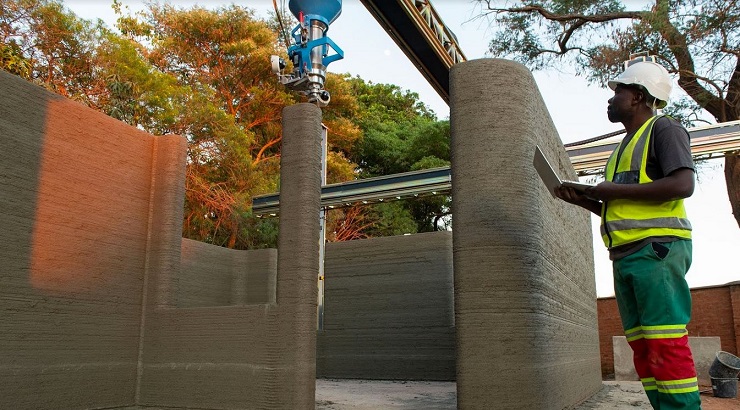Features
10 Construction Industry Trends to Watch in 2025
An overview of new trends shaping the global construction industry.

As builders match into the future of construction, new construction industry trends are emerging all over the world, dramatically changing how we build.
The new construction trends range from robotics and 3D printing to smart buildings and wearables – all aimed at reducing costs, improving efficiency and creating safer and more sustainable structures.
Here are some of the emerging trends in the construction industry.
Construction industry trends
1. 3D printing
3D printing of one of the most popular emerging trends in the construction industry.
It entails the use of a special printer and ‘ink’ to create three-dimensional objects – including multi-storey buildings layer by layer.
This technology is gaining currency among builders due to its ability to create very accurate designs quickly with little material wastage and lower costs.
3D printing technology also allows for the construction of complicated structures in only a few days, which makes it handy, especially during emergencies.
2. Building information modelling
Building information modelling is a technology that utilizes special BIM software to generate detailed 3D models of buildings.
It’s a technology that allows construction stakeholders to model collaborative construction stakeholder environments and share project data in a virtual space – easily fast-tracking issues and problems that could be encountered during actual construction.
With the potential of cost reduction and increased collaboration, eventually leading to efficiency, BIM currently ranks as one of the top trends in the construction industry.
3. AI-oriented drones
While drones were engaged in ages of service by collecting data from dangerous and inaccessible sites, drones represent one of the hottest construction trends today.
Thanks to technology, drones are now AI-oriented and fitted with cameras that can capture better images and details that improve communication between them and software on the receiving end.
As such, drones can now offer real-time aerial imagery, 3D lidar scans, BIM capabilities, progress tracking, safety monitoring, inspections, and more.
This is helping site managers and engineers to make more informed decisions and to better understand the project’s progression.
4. Safety technology and wearables
As builders focus on on-site safety, wearables such as exoskeletons and smart helmets are becoming one of the most popular construction technology trends.
The safety devices can help monitor the movement of a worker, provide real-time data on site conditions, and prevent common injuries such as back strain.
RELATED: Top 10 Construction Technology Trends to Watch
Wearables are likely to become a standard feature in the construction industry as builders seek to enhance worker safety while improving productivity.
5. Robotics
Robotics are one of the fastest growing construction trends as builders seek to automate some of the most repetitive tasks such as bricklaying and rebar tying.
This is helping to relieve workers of the burden of handling repetitive work.
And since robots can work without stopping, construction work can be completed much faster as compared to the timelines achievable by human workers.
6. Green construction
Also known as sustainable construction, green construction has been one of the hottest construction industry trends over the past decade.
This is because governments around the world have been pushing for the use of eco-friendly materials and energy-efficient technologies to tackle climate change.
Green construction seeks to cut the energy consumption of buildings and reduce the wastage of building materials while improving indoor air quality and the overall health and well-being of a building’s occupants.
This will keep happening as countries aim for carbon neutrality.
7. Prefabrication
Prefabrication is a construction technique that involves the use of factory-made building components that are transported to the site for assembly.
This technique allows for greater precision and quality control. It also shortens construction timelines while reducing the wastage of building materials.
The popularity of prefabrication is likely to grow further as more builders embrace the technique as a means to improve efficiency and reduce building costs.
8. Modular construction
Like prefabrication, modular construction involves the use of pre-made building components that are shipped to the site for assembly.
However, it takes prefabrication a step further by creating entire building modules off-site and shipping them to the site for assembly-like building blocks.
Modular construction offers the potential for greater efficiency and cost reduction, which makes it popular among large construction companies.
Indeed, the global modular construction market – which was valued at $82.3 billion in 2020 – is expected to hit $108 billion by 2025.
9. Smart buildings
Property developers are increasingly incorporating smart technologies such as building automation systems, energy management systems, and sensor-based monitoring systems to improve the performance of their buildings.
Smart buildings are expected to become more prevalent in the global construction market as more people seek to make their property more sustainable and efficient.
10. Mass timber construction
Mass timber construction is a building technique that uses engineered wood panels, columns, and beams to build tall buildings.
Thanks to the environmental benefits of wood products, durability, and aesthetic appeal of wooden structures, mass timber construction is among the fastest emerging trends in the construction industry.
This trend is likely to continue as the demand for sustainable and eco-friendly building materials grows in many parts of the world.














